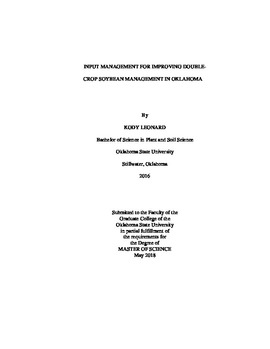| dc.description.abstract | Double-crop soybean is a valuable production system in Oklahoma. However, due to the later planting date paired with environmental conditions present throughout the state, the high yield potential is associated with some degree of risk. Due to this high risk, growers have to appropriately manage inputs in order to minimize other risk factors. A trial was established in the spring of 2016 and 2017 near Perkins, Oklahoma on a sandy loam soil. Seven inputs were evaluated (previous wheat variety, seeding rate, row spacing, insecticide, fungicide, in-season N, foliar micronutrients, and seed treatment). These were evaluated based on a standard practice level and a high management level (i.e., farmer practice for N-management would be no additional N applied and high management would be 112 kg ha-1 N applied). In addition, a standard practice and high rate management check was added by fixing all inputs at those individual levels to allow comparison of the individual inputs. Stand counts were taken at V3, plant height at R2, NDVI at R3 and yield characteristics (percentage of two- and three-bean pods, pods plant-1, pods node-1, nodes plant-1 and seed weight g 1000 seeds-1) were taken at R8. Yield was determined by mechanically harvesting the middle 1.67 m of the plot. The high input system resulted in significantly higher yields than the standard practice system both years. Compared to high management system, only decreasing seeding rate resulted no significant differences (99 kg ha-1 increase) with all other treatments resulting in significant decreases (47 to 149 kg ha-1 decrease) in 2016. Compared to the high management system, only taking away micronutrients resulted in an increase (80 kg-1 ha-1) with all other treatments resulting in decreases (15 to 824 kg ha-1 decrease) in 2017. This could indicate that higher seeding rates resulted in too many plants ha-1 due to poor environmental conditions and micronutrients are not needed within a double crop system. This increase in yield was possibly due to increased seed weight, lower plant population which resulted in a significant decline in pods plant-1 and no significant differences in the number of two- and three-bean pods. | |
